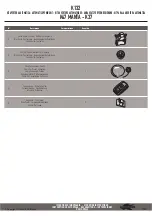
20
RIDE WITHIN YOUR ABILITIES
considered enough time and space to
swerve and/or brake for fixed hazards or
for someone or something entering your
path of travel.
Finally, experienced riders search for
hazards that are further out, looking
ahead to an area it would take about
12 seconds to reach. This provides
time to prepare for a situation before it
becomes immediate.
Using the SEE strategy will help you to
Search
for a variety of factors such as:
L
Oncoming traffic
that may turn left
in front of you.
L
Traffic
coming from the left and
from the right.
L
Traffic
approaching from behind.
SEE
Good, experienced
riders are always aware of
what is going on around
them. They reduce their
risk by using MSF’s three-
step SEE
SM
strategy:
I
S
earch
I
E
valuate
I
E
xecute
SEE will help you
assess what is going on
in traffic so you can plan
and implement the safest
course of action as traffic
situations change. Let’s
look at each of these
steps.
Search
How assertively you
search, and how much
time and space you have,
can eliminate or minimize
risk. As you search, focus
on finding potential escape routes,
especially in or around intersections,
shopping areas and school and
construction zones.
One way to search is to use your
“RiderRadar” to aggressively scan the
environment ahead of you, to the sides,
and behind you to avoid potential
hazards even before they arise. There
are three “lead times” experienced
riders consider. First, be alert and scan
for hazards that are about 2 seconds
ahead of you, or within your following
distance. Scanning your 4-second
immediate path can allow you time for
a quick response if something should
go wrong. Anything that is within 4
seconds of your path is considered
immediate because 4 seconds is
RIDER RADAR
















































